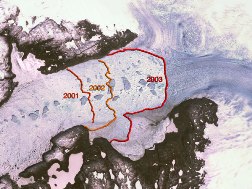
New research suggests that the warming of the sea and the consequent break-up of its floating ice-shelf, had a role to play in the acceleration of Greenland's Jakobshavn glacier. Sarah Day reports.
Geoscientist Online 13 October 2008
The rapid increase in the speed of several glaciers in Greenland and Antarctica may be caused by the effect of climate change on ocean and atmospheric circulation in the North Atlantic, a study published in the October edition of the journal
Nature Geoscience suggests.
The acceleration has been observed in several glaciers that drain the Greenland ice sheet over the past decades. In particular, Jakobshavn Isbrae, a large glacier that feeds a deep-ocean fjord on Greenland’s west coast, has roughly doubled in velocity since 1997. It has previously been suggested that the cause may be recent warm summers, which have resulted in more meltwater draining into the glacier bed and lubricating the interface between the ice and the bedrock.
However, the researchers, led by Professor David M Holland at New York University, found that there was a significant increase in subsurface ocean temperatures at the mouth of the Jakoshavn ocean fjord from 1997, which coincides with the onset of Jakobshavn Isbrae’s acceleration. Coincidentally, surveys made for northern shrimp at trawl sites over nearly the entire western Greenland continental shelf recorded bottom temperatures, which provided the researchers with further data. This indicated a striking, substantial jump in bottom temperatures in all parts of the survey area during the second half of the 1990s, again coinciding with the rapid acceleration of the glacier.
The data has allowed the team to develop a mechanism to explain why such rapid acceleration of glaciers has been observed. They suggest that a warm water pulse travelled along the west Greenland coast during the 1990s, bringing with it an increase in subsurface water temperature over the continental shelf and arriving at the mouth of the Jakobshavn ocean fjord in 1997. According to the model, this pulse of warm water then flooded the fjord, resulting in warm bottom waters which have prevailed ever since. As a result, the glacier rapidly thinned, leading to the break-up of the floating ice tongue. This break up would produce an immediate increase in longitudinal stretching of the glacier, and therefore an increase in its speed.
The researchers argue that the original cause of the ocean warming was a change in wind patterns over the North Atlantic, which moved the boundary between cold polar waters and warm subpolar waters to a more westerly position, allowing warm subpolar waters to spread westerwards over the west Greenland continental shelf. If correct, the research suggests that an improved understanding of the effect of changes in atmospheric and ocean circulation is required, if the consequences of climate change for glacier movement are to be better understood in the future.
Holland, David et al., 2008. Acceleration of Jakobshavn Isbrae triggered by warm subsurface ocean waters. Nature Geoscience Vol 1 October 2008 pp659-664